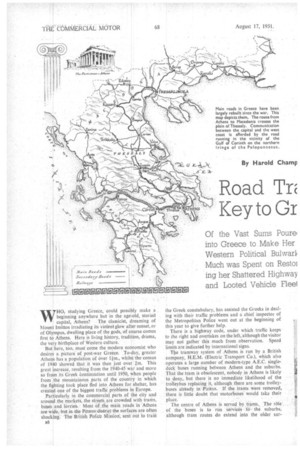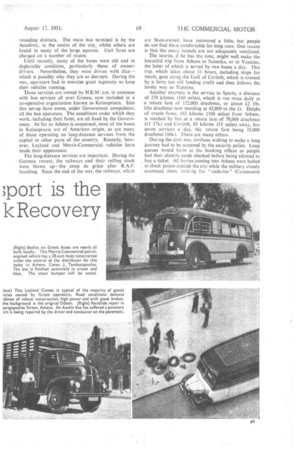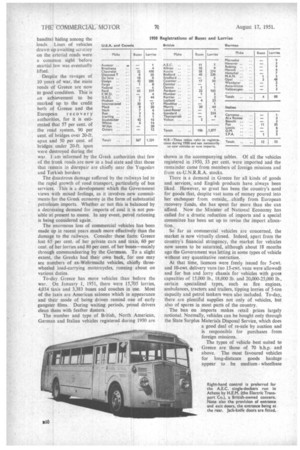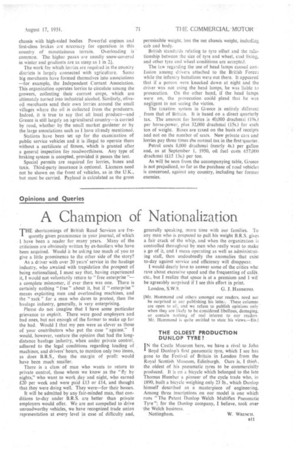Road Tn Key to Gr ;port is the k Recovery
Page 42

Page 43

Page 44

Page 45

If you've noticed an error in this article please click here to report it so we can fix it.
WHO, studying Greece, could possibly make a beginning anywhere but in the age-old, storied
capital, Athens? The classicist, dreaming of Mount Imittos irradiating its violent glow after sunset, or of Olympus, dwelling place of the gods, of course comes first to Athens. Here is living history, tradition, drama, the very birthplace of Western culture.
But here, too, must come the modern economist who desires a picture of post-war Greece. To-day, greater Athens has a population of over 1/m., whilst the census of 1940 showed that it was then just over /m. This great increase, resulting from the 1940-45 war and more so from its Greek Continuation until 1950, when people from the mountainous parts of the country in which the fighting took place fled into Athens for shelter, has created one of the biggest traffic problems in Europe.
Particularly in the commercial parts of the city and around the markets, the streets are crowded with trams, buses and lorries, Most of the main roads in 'Athens are wide but in the Pirmus7district the surfaces are often shocking: The British Police Mission; sent out to train B8 the Greek constabulary, has assisted the Greeks in dealing with their traffic problems and a chief inspector of the Metropolitan Police went out at the beginning of this year to give further help.
There is a highway code, under which traffic keeps to the right and overtakes on the left, although the visitor may not gather this much from observation. Speed limits are indicated by international signs.
Tbe tramway system of Athens is run by a British company, H.E.M. (Electric Transport Co.), which also operates a large number of modern-type A.E.C. singledeck buses running between Athens and the suburbs. That the tram is obsolescent, nobody in Athens is likely to deny, but there is no immediate likelihood of the trolleybus replacing it, although there are some trolleybuses already in Piraeus. If the trams were removed, there is little doubt that motorbuses would take their place.
The centre of Athens is served by trams.. The rale , of the buses is to run services to the suburbs, although tram routes do extend into the older sur
rounding districts. The main bus terminal is by the Academy, in the centre of the city, whilst others are found in many of the large squares. Unit fares are charged on a number of routes.
Until recently, many of the buses were old and in deplorable condition, particularly those of ownerdrivers. Nevertheless, they were driven with elan-which is possibly why they are so decrepit. During the war, operators had to exercise great ingenuity to keep their vehicles running.
Those services not owned by H.E.M. are, in common, with bus services all over Greece, now included in a co-operative organization known as Koinopraxia. Intothis set-up have-come, under Government compulsion, all the bus operators. The conditions under which they work, including their fares., are all fixed by the Government. As far as Athens is concerned, most of the buses in Koinopraxia are of American origin, as are many of those operating on long-distance services from the capital to other parts of the country. Recently, however, Leyland and Morris-Commercial vehicles have made their appearance.
The long-distance services are important. During the German retreat, the railways and their rolling stock were blown up—the coup de grace after R.A.F. bombing. Since the end of the war, the railways, which
are State-owned, have recovered a little, but people do not find the ii comfortable for long runs. One reason is that the many tunnels are not adequately ventilated. The tourist, if he has the time,. might well make the .beautiful trip from Athens to Salonika, or to Yannina, the latter of which is served by two buses a day. This trip. which takes about 11 hours, including stops for meals, goes along the Gulf of Corinth, which is Crossed by a ferry (an old landing craft) and then follows the lovely way to Yannina.
Another example is the service to Sparta, a distance of 258 kitorns. (160 miles), which is run twice daily at a return fare of 122,000 drachmai, or about E2 19s. (the drachrnai now standing at 42,000 to the f). Delphi of oracle fame, 162 kiloms. (100 miles) from Athens, is reached by bus at a return fare of 78000 drachmai (-El 17s.) and Corinth, 83 kilorns. (53 miles) away, has seven services a day, the return fare being 33,000 drachmai (16s.). There are many others.
During the civil war, civilians wishing to make a long journey had to be screened by the .security police. Long queues would form at the booking offices as people had their identity cards checked before being allowed to buy a ticket. All lorries coming into Athens were halted at cheek points outside the city while the military closely examined them, looking for " andartes " (Communist bandits) hiding among the loads. Lines of vehicles drawn up awaiting scrutiny on the arterial roads were a common sight -before martial law was eventually lifted.
Despite the ravages of 10 years of war, the main roads of Greece are now in good condition. This is an achievement to be marked up to the credit both of Greece and the European recover y authorities, for it is estimated that 57 per cent. of the road system, 90 per cent. of bridges over 20-ft. span and 50 per cent. of bridges under 20-ft. Span we e destroyed during, the war. I am informed by the Greek authorities that few of the trunk roads are now in a bad state and that those that remain in disrepair are chiefly near the Yugoslav and Turkish borders The disastrous damage suffered by the railways led to the rapid growth of road transport, particularly of bus services. This is a development which the Government views with mixed feelings, as it involves new commitments for the Greek economy in the form of substantial petroleum imports. Whether or not this is balanced by a decreasing demand for imports of coal it is not possible at present to assess. In any event, petrol rationing is being considered again. The enormous loss of commercial vehicles has been made up in recent years much more effectively than the damage to the railways. Consider these facts: Greece lost 65 per cent. of her private cars and taxis, 60 per cent, of her lorries and 80 per cent. of her buses—mainly through commandeering by the Germans. To a slight extent, the Greeks had their own back, for one may see numbers of ex-Wehrmacht vehicles, chiefly threewheeled load-carrying motorcycles, running about on various duties.
To-day Greece has more vehicles than before the war. On January 1, 1951, there were 15,705 lorries, 4,034 taxis and 3,383 buses and coaches in use. Most of the taxis are American saloons which in appearance and their mode of being driven remind one of early gangster films. During waiting periods, proud drivers clean them with feather dusters.
The number and type of British, North American, German and Italian vehicles registered during 1950 are
Rea Sterling .. Studebaker White ..
Others , 15 14 20 12 Totals .. 267 1,231
shown in the accompanying tables. Of all the vehicles registered in 1950, 33per cent, were imported and the remainder came from members of foreign missions and from ex-U.N.R.R.A. stocks.
There is a demand in Greece for all kinds of goods and, services, and English products have always been liked. However, so great has been the country's need for goods that, despite vast sums of money poured into her exchequer from outside,, chiefly from European recovery funds, she has spent far more than she can afford. Now the Minister of National Economy, has called for a drastic reduction of imports and a special committee has been set up to revise the import allocation.,
So far as commercial vehicles art concerned, the market is now virtually closed. Indeed, apart from the country's financial stringency, the market for vehicles now seems to be saturated, although about 18 months ago the Government was letting in some types of vehicle without any quantitative restriction_ At that time, licences were freely issued for 5-cwt. and 10-cwt. delivery vans (no 15-cwt. vans were allowed) and for bus and lorry chassis for vehicles with gross capacities of 15,000 lb., 18,000 lb. and 20,000-25,000 lb., certain specialized types, such as fire engines, ambulances, tractors and trailers, tipping lorries of 5-ton capacity and petrol tankers were also included. To-day, there are plentiful supplies not only of vehicles, but also of spares in most parts of the country.
The ban on imports makes retail prices largely notional. Normally, vehicles can be bought only through the State Surplus Materials Disposal Service, which does a good deal of re-sale by auction and is responsible for purchases from foreign missions.
The types of vehicle best suited to Greece are those of 70 b.h.p. and above. The most favoured vehicles for long-distance goods haulage appear to be medium wheelbase chassis with high-sided bodies Powerful engines and first-class brakes are necessary for operation in this country of mountainous terrain. Overloading is common. The higher peaks are usually snow-covered in winter and gradients are as steep as I in 21.
The work for which lot vies are required in the country districts is largely connected with agriculture. Some big merchants have formed themselves into associations —for example, the Independent Currant Association. This organization operates lorries to circulate among the growers, collecting their currant crops, which are ultimately turned into industrial alcohol. Similarly, oliveoil merchants send their own lorries around the small villages where the oil is collected from the producers. Indeed, it is true to say that all local, produce—and Greece is still largely an agricultural country—is carried by road, whether by the small market gardener or by the large associations such as I have already mentioned.
Stations have been set up for the examination of public service vehicles and it is illegal to operate them without a certificate of fitness, which is granted after a general inspection for roadworthiness. Any type of braking system is accepted, provided it passes the test.
• Special permits are required for lorries, buses and taxis. Third-party insurance is optional. Licences need not be shown on the front of vehicles, as in the U.K., but must be carried. Payload is calculated as the gross permissible weight, less the net chassis weight, includ'ing cab and body.
British standards relating to tyre offset and the relationship between the size of tyre and wheel, stud fixing, and other tyre and wheel conditions are accepted.
The law regArding the use of head lamps caused confusion among drivers attached to the British FOICZ3 while the infantry battalions were out there. It appeared that if a person were knocked down at night and the driver was not using the head lamps, he was liable to prosecution. On the other hand, if the head lamps were on, the prosecution could plead that he was negligent its not seeing the victim.
The taxation system in Greece is entirely different from that of Britain. It is based on a direct quarterly tax. The amount for lorries is 40,000 drachmai (19s.) per horse-power, plus 32,000 drachmai (15s,) for each ton of weight. I3uses are taxed on the basis of receipts and not on the number of scats. New private cars and lorries pay three times the normal tax in the first.quarter.
Petrol costs 8,000 drachmai (nearly 4s.) per gallon and, as at September 1, 1950, oil fuel costs. 657,000 drachmai (£15 13s.) per ton.
As will be seen from the accompanying table, Greece is not prejudiced, so far as the purchase of road vehicles is concerned, against any country, including her former enemies.




















































































